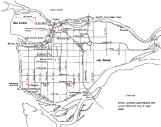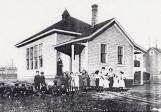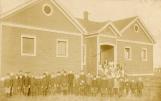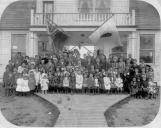1
In 1885 there were few settlers at the mouth of the Fraser River. Virgie English started teaching her three younger brothers in her home. Later she conducted classes for other children of early settlers in a small building used as a post office at her father's Phoenix Cannery wharf.In 1887 Mr. Robertson, a retired teacher from Ontario rowed across the river from Westham Island every day to teach at the new church at London's Landing at the foot of Number 2 Road.
In 1888, the provicial government built Richmond's first real school, a little one-room school house at Number 2 Road and Steveston Highway in the English School District named after Mr. English, one of the first trustees. The first teacher, Mr. Muir, had his teaching certificate taken away when he complained about the curriculum to the newspapers.
In 1893 a new English School was constucted at Shell Road and Steveston Highway and the Number 2 Road School became part of the Steveston School District.
4
When Steveston was founded in 1890, parents complained of the long walk (1.5 miles) to the Number 2 Road School along roads that were at best, planked, and at worst just ruts in the mud or trails along a slough bank. School classes were held closer to home in the Opera House at Second Ave. and Chatham St., in a small building between Chatham and Moncton on Second Ave., which later became an ice- cream parlour, and in the Methodist Indian Mission at No. 2 Rd. and Chatham.In 1897 Steveston's first real school was build at Second Ave. and Georgia St.
6
By 1904, this one-room yellow school house was too small and a two-room school was built and painted green. The yellow school stood at the back and was used as storage and a playroom.In 1906 there were 35 children from 20 families at Steveston School in two classes which included grades 1 to 7.
7
In 1906 the provincial government reduced the number of school districts and Steveston was amalgamated into Richmond School District.9
When Japanese families and mail order brides were allowed to immigrate, Steveston's population of Japanese families increased dramatically. Most Japanese families were tenants of the canneries. In 1907, when the Japanese Canadian population requested permission for their children to attend Steveston School the School Board ruled that only children of "known residents of Steveston could attend". As a result, the Japanese community raised funds to build their own school and hire teachers. The first Japanese School consisted of two classrooms with a covered porch area between them. It was situated on the east side of No. 1 Road near Chatham Ave. Eventually, another two classrooms and a large hall were added to the back of the school forming a u shaped building. The open area was planked to provide a dry playground in winter. It was also used for sumo wrestling.12
In 1921 construction of two rooms of a new Steveston School began beside the old school. The Japanese community raised funds to help pay for the building and two more rooms were added by 1925. During this time the school was renamed Lord Byng, in honour of the Governor General of Canada.Japanese students were able to attend the same school as white students for the first time in a decade. Even so, there still was a shortage of classrooms so the Japanese School building as well as St. Anne's Parish Hall on 4th Ave. were used as annexes to Steveston/Lord Byng.
14
By 1928 crowding in the Japanese classes was acute. The Japanese community appealed to the School Board for more classrooms but were turned down. An appeal to the Department of Education resulted in a promise to match whatever amount the community could raise toward the cost of building another new school.In spite of the depression at the time, they raised $20,000. The School Board contributed $8,000 for the furnishings. Once again the Japanese community had built a new school, this time with 14 rooms. Now students of all races were able to attend the same school together.






